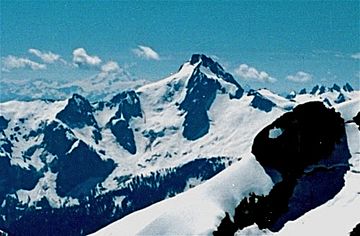Mount Blum facts for kids
Quick facts for kids Mount Blum |
|
|---|---|

Mount Blum seen from Ruth Mountain
|
|
| Highest point | |
| Elevation | 7,685 ft (2,342 m) NAVD 88 |
| Prominence | 3,280 ft (1,000 m) |
| Geography | |
| Parent range | Cascade Range |
| Topo map | USGS Mount Blum |
| Geology | |
| Age of rock | 15,000 years |
| Volcanic arc | Cascade Volcanic Arc |
| Climbing | |
| Easiest route | Rock/ice climb |
Mount Blum, also known as Mount Bald, is a tall mountain in the North Cascades range in Washington state. It stands about 7,685-foot (2,342 m) high, right on the western edge of North Cascades National Park. It's the tallest peak among a group of mountains found east of Mount Shuksan and west of the Picket Range. You can find two small, active glaciers on its northern side. Mount Blum was named after John Blum, a United States Forest Service fire patrol pilot who sadly crashed nearby in 1931.
Six small lakes, called tarns, are found on the southeast side of the mountain. These lakes, known as the Blum Lakes, are fed by glaciers. Other ice sheets are spread across the bowls and valleys on Mount Blum and nearby peaks. Blum Creek, a stream named for the mountain, flows north and west from Mount Blum into the Baker River. The Baker River then flows into the Skagit River. Part of the Baker Lake reservoir, which holds water from the lower Baker River, touches Mount Blum on its far northeastern side. Lonesome Creek and Scramble Creek also drain valleys near Mount Blum. The steep cliffs in these valleys create some very tall waterfalls, like the 1,680-foot (510 m) Blum Basin Falls.
People sometimes go skiing on the slopes of Mount Blum. Even though skiing is popular, Mount Blum is mostly surrounded by wild areas without trails. The only main connection is a southern ridge that leads to Mount Hagan. Mount Blum is made of very strong granite rock. This type of rock is common in the area and is much tougher than the softer rock found in Mount Shuksan and the Picket Range.
Contents
Mountains Near Mount Blum
Mount Blum is surrounded by other impressive peaks. Here are a few of them:
Weather and Climate Around Mount Blum
Mount Blum is located in a marine west coast climate zone. This means it gets a lot of moisture from the Pacific Ocean. Most weather systems start over the Pacific and move northeast towards the Cascade Mountains.
How Mountains Affect Weather
When these weather systems reach the North Cascades, the tall peaks force the air upward. As the air rises, it cools down and drops its moisture. This process is called orographic lift. It causes a lot of rain or snowfall on the western side of the North Cascades, especially in winter.
Seasonal Weather Patterns
During winter, the weather is usually cloudy. However, in summer, high-pressure systems over the Pacific Ocean often bring clear skies. Because of the ocean's influence, the snow tends to be wet and heavy. This can lead to a high risk of avalanches.
The Geology of Mount Blum
The North Cascades area has some of the most rugged land in the Cascade Range. You can see jagged peaks, sharp spires, long ridges, and deep valleys carved by glaciers. These amazing landscapes were formed by geological events that happened millions of years ago. These events created the varied landforms and big changes in elevation that lead to different climates.
How the Cascade Mountains Formed
The Cascade Mountains began to form millions of years ago, during the late Eocene Epoch. At that time, the North American Plate was slowly moving over the Pacific Plate. This movement caused many periods of volcanic activity. Also, small pieces of the Earth's crust, called terranes, came together to form the North Cascades about 50 million years ago.
The Impact of Glaciers
During the Pleistocene period, which was over two million years ago, glaciers repeatedly moved across the land. As they advanced and retreated, they carved out the landscape and left behind rock debris. The "U"-shaped valleys you see today were formed by these recent glaciers. The combination of land being pushed upward (uplift), cracks forming in the Earth's crust (faulting), and glaciation has created the tall peaks and deep valleys of the North Cascades.
Images for kids


